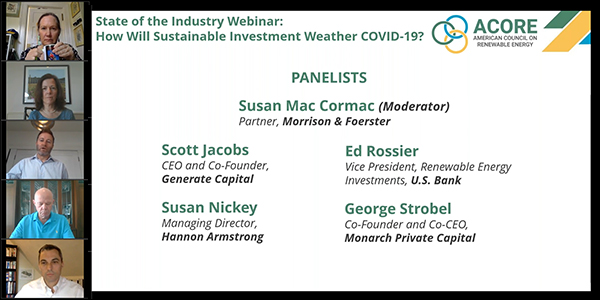Wind and solar energy resource developers are bracing for a tumultuous year, but investors last week expressed confidence that renewables were poised for a rebound when the U.S. economy recovers from the COVID-19 pandemic-induced downturn.
In a webcast hosted by the American Council on Renewable Energy on Wednesday, investors in renewable resources said that despite some short-term delays, most projects that were already under construction before the downturn are still on target for completion, as construction work has been deemed critical.
“We are starting to see delays in some places, primarily just due to shelter-in-place orders where people are not able to access sites and … not able to get the attention of government officials to proceed through development milestones that require permitting,” Generate Capital CEO Scott Jacobs said. But he said that even amid the pandemic, his firm has raised $300 million worth of equity and “closed on a significant amount of new project financing debt capital.”
“So the money is flowing. … There is a lot of appetite for these kind of resilient investment opportunities, and if we just changed the word ‘sustainable’ to ‘resilient,’ we might actually appeal to a wider pool of people.”
George Strobel, co-CEO of Monarch Private Capital, said his company has not seen any of its projects experience supply chain disruptions because those that had 2020 target dates had started ordering supplies last year.
BloombergNEF Head of Americas Ethan Zindler began the webinar with an analysis of the pandemic’s impact on renewable development this year. The company projects 22 GW in total renewable capacity additions in the U.S., down 20% from its estimate earlier this year, before the crisis began. (See US Renewable Investment Hits Record $55.5B.)
He noted the figure was much lower than the U.S. Energy Information Administration’s projection of about 32.7 GW earlier this month, with wind and solar down 5% and 10%, respectively, from the agency’s report last month. (See EIA: Renewable Capacity to Grow in 2020.)
Zindler also noted that “delays are not cancellations.” For example, he projected utility-scale solar additions to decrease slightly this year, to 6.8 GW, but then skyrocket to 14.8 GW in 2021.
The panelists were asked by moderator Susan Mac Cormac, a partner with Morrison & Foerster, whether the crisis is making investing in renewables even more attractive.
Jacobs said many investors “are interested in the uncorrelated risk that these assets represent relative to the rest of their portfolio. And so, while that has been a pitch made by pitchmen for many years about renewable energy and infrastructure, it has also been proven true in recent years in these kinds of macroeconomic disruptions like we’re seeing right now.”
“I don’t foresee a snapback to the way of thinking short-term and ignoring problems that seem too big to challenge,” said Ed Rossier, vice president of renewable energy investments for U.S. Bank. “And on top of that, we’re going to see a lot of data after this is over showing the inequitable impact on people in this country … and it’s going to be really hard to ignore that.”
Zindler’s determinations were based on the optimistic assumption that there is “substantial short-term disruption” in global economies over the next three months, before growth resumes in the fourth quarter. BloombergNEF, however, is developing analyses on more dire scenarios. The first assumes that major outbreaks occur in two to three waves over the next year, with economies restarting every few months only to shut down again, and global growth only picks back up in the second quarter of 2021.
Such a scenario, Strobel said, was his company’s biggest worry.
“We’re doing fine right now,” Strobel said. “I think this is an event proving that a diversified business model makes sense.” Along with renewable energy, Monarch invests in low-income housing and renovations of historic buildings, as well as in the federal tax credits for those types of projects. “Our worries are that … things will get better this summer, but what if they get worse come October? That for us is our biggest concern.
“All of us [referring to the panel] are fine; we have cash in our checking accounts, and we have investment savings, but most of the people in this country don’t have an investment portfolio, and they’re running out of cash. So if we have a renewal of this crisis in the fall, that’s going to be very catastrophic for our economy.”
The second scenario being developed by BloombergNEF, however, would be far more catastrophic: Virus outbreaks continue until a vaccine is developed, which health experts have said will take at least a year and a half.






